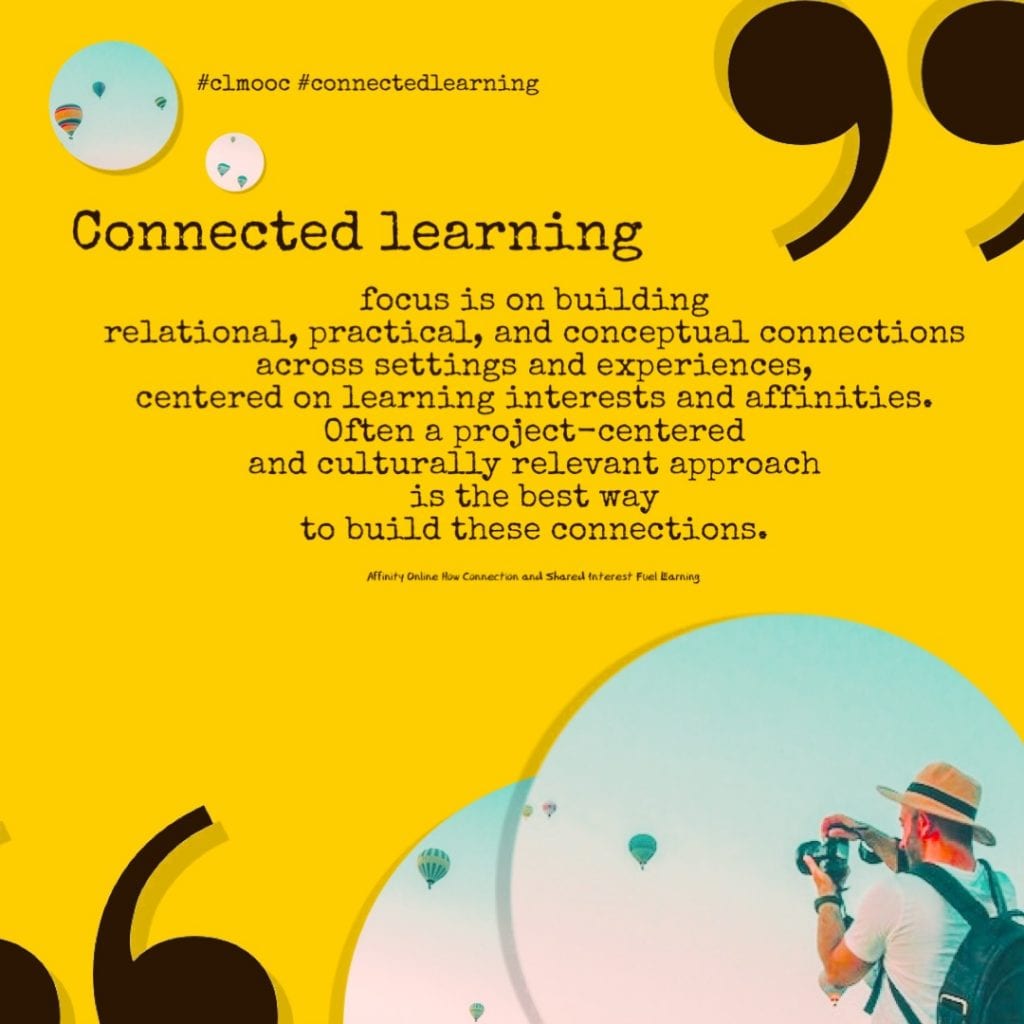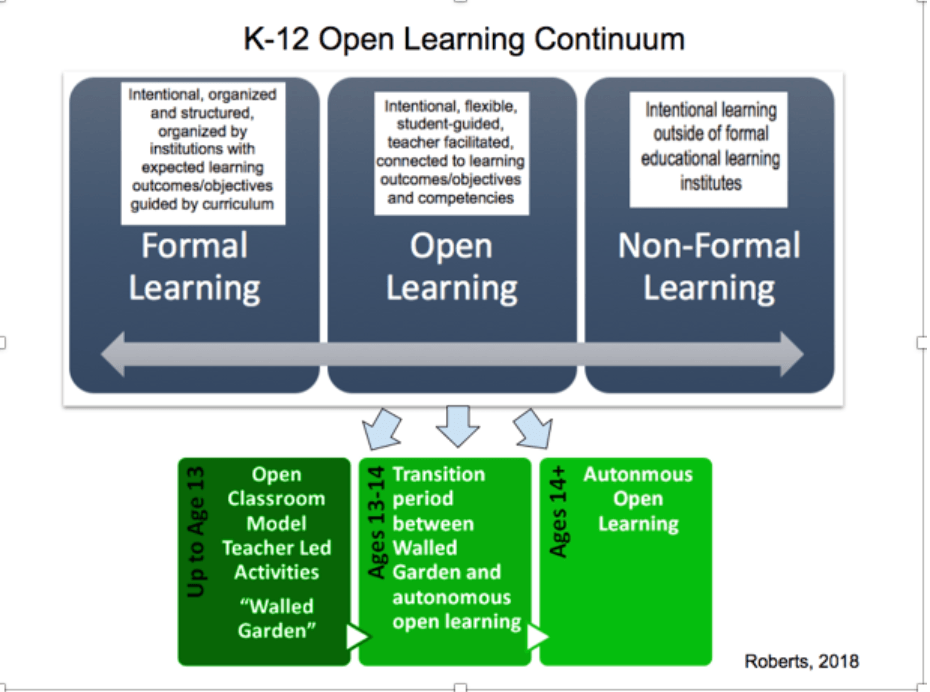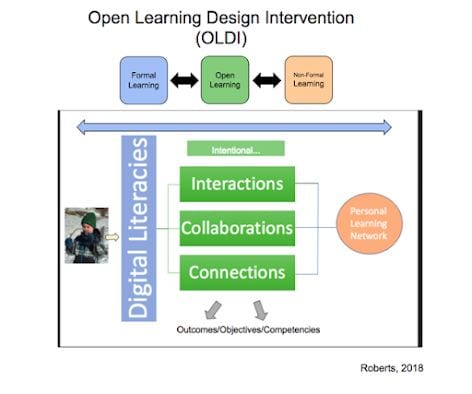A Book Club’s Questions
In pursuit of understanding the ways that young people join online communities of interest, CLmooc delves into the book Affinity Online through a slow twitter chat over the month of March at #CLmooc. In particular, the book and the group wonder how that understanding can help bring that enthusiasm from out of school online affinity communities into schools.
I posted the above image on Twitter and Verena Roberts responded:
Trying to figure out how that quote in particular is different from open learning ? Do you have any suggestions ?
— Verena Roberts (@verenanz) March 5, 2019
My response was:
Good question: I would think only that the focus here is to connect individuals to interest groups and that to learning— especially bring into classrooms in ways that honor the individual’s drive and purpose in that interest. Open and connected. Same? Similar?
— Sheri Edwards (@grammasheri) March 5, 2019
However, Verena is actively pursuing open, connected learning in her school district in ways that scaffold the elements of connected learning for schools, their teachers, and their students. So I pondered this question more, hoping for more examples of creating schools that are as engaging for students as affinity networks [nonschool interest groups where young people excel in learning and sharing their interest].
And that’s what Verena’s websites and blog provided.
Open Education
At the district’s website, Open Education is explained as:
Open educational practice is a learning perspective which emphasizes student voice, identity and culture by ensuring equitable access to learning resources and opportunities for all students. The focus of open learning is on sharing and building knowledge for all learners and encouraging learner participation in safe, respectful and supportive learning spaces. In K-12 learning contexts, there is a continuum of openness which considers how much learning occurs in publicly open environments which is dependent upon the individual open readiness (Cronin, 2017) of learners and teachers. “Open practice is not a one-time decision. It is a succession of personal, complex, and nuanced decisions” (Cronin, 2017). Rocky View Schools Digital Literacy
“Voice, identity, and culture” are main features of affinity communities — where participants are comfortable to share their ideas which inform their identity within the culture of that community.
In particular, this program is designed to bridge the gap from offline to in school learning:
Open educational practices (OEP) can help support the expansion from one formal learning space into multiple non-formal learning spaces because the student is in control of the learning environments that they wish to explore. Open learning can occur in any classroom context or environment but does not require technology, the only essential factor is that all learners to connect with networks and learning opportunities outside the classroom.
So, yes — open education is connected learning:
“… focus is on building relational, practical, and conceptual connections across settings and experiences, centered on learning interests and affinities.”
What is this Open Education Program?
This diagram shows the open learning continuum through K-12, starting with a walled garden and then opening into non-formal learning, as created by Verena.
How does that look in the curriculum?
The Open Learning Design Intervention model shows the connection — formal learning content including digital literacies connect personal learning networks through intentional interactions, collaborations, and connections while learning the competencies required.
In Verena’s post about OLDI, she explains the stages for learners that scaffold the design with teachers as a guide:
- Stage 1: Focus on Learner Context – Build Relationships
- Stage 2: Development of Digital Literacies
- Stage 3: Find Your Yoda [find expert]
- Stage 4: Be a Yoda [teach / share with others]
This is amazing work within a school district– connecting student interests, encouraging their voice, connecting with experts and interest communities, and meeting learning competencies at the same time. Verena explains just how care was taken for:
- the trust and relationship between the teacher and student,
- the digital literacy skills of the learner (learners can get too focused on a tool and lose sight of the intention to share their learning experiences),
- the cognitive and developmental level of the learner;
- the consideration of a learner’s digital identity in terms of future implications and;
- the school district policy and government privacy laws.
- from OLDI post
These are important– and Verena pointed to another research study that shows that the institution must support the process:
the findings of this study highlight the need for institutions to work broadly and collaboratively to build and support academic staff capacity in three key areas: developing digital literacies and digital capabilities; supporting individuals in navigating tensions between privacy and openness; and, critically, reflecting on the role of higher education and our roles as educators and researchers in an increasingly open and networked society.
Catherine Cronin
Openness and Praxis: Exploring the Use of Open Educational Practices in Higher Education Volume 18, Number 5 August – 2017 International Review of Research in Open and Distributed Learning
How is support by the school achieved?
It’s important for teachers interested in open learning, connected learning, and educational reform to
- know the research
- share their individual classroom work
- and collaborate with others to share their process and results
This will build a repertoire of information of real experiences and examples based on research and reality to inform school districts as to what is possible, as Verena has done in her work.
Open: Share and Make Aware
Real examples based on research and reality builds awareness. In order for equity in educational opportunities — so all have access– this collection of examples is an imperative. Awareness brings awakening so change occurs in more school districts. Institutional change is slow — but the CLA [Connected Learning Alliance] and their research such as in the Affinity Online book are places for connection for those teachers innovating within their classrooms. Following #OEP and #CLmooc hashtags provide connections for people and resources.
Participatory Culture
Besides the CLA [Connected Learning Alliance], Henry Jenkins has been researching “participatory culture” for years. In 2006 he wrote Confronting the Challenges of Participatory Culture: Media Education for the 21st Century.
We are a participatory culture– most people are sharing and creating online.
Jenkins explains participatory culture:
A participatory culture is a culture with relatively low barriers to artistic expression and civic engagement, strong support for creating and sharing one’s creations, and some type of informal mentorship whereby what is known by the most experienced is passed along to novices.A participatory culture is also one in which members believe their contributions matter, and feel some degree of social con- nection with one another (at the least they care what other people think about what they have created). Forms of participatory culture include:
Affiliations — memberships, formal and informal, in online communities centered around various forms of media, such as Friendster, Facebook, message boards, metagaming, game clans, or MySpace).
Expressions — producing new creative forms, such as digital sampling, skinning and modding, fan videomaking, fan fiction writing, zines, mash-ups).Collaborative Problem-solving — working together in teams, formal and informal, to complete tasks and develop new knowledge (such as through Wikipedia, alternative reality gaming, spoiling).
Circulations — Shaping the flow of media (such as podcasting, blogging).~ Henry Jenkins Confronting the Challenges of Participatory Culture: Media Education for the 21st Century
In the paper, Jenkins indicates that policy and pedagogical changes must occur for three reasons:
The Participation Gap — the unequal access to the opportunities, experiences, skills, and knowledge that will prepare youth for full participation in the world of tomorrow.
The Transparency Problem — The challenges young people face in learning to see clearly the ways that media shape perceptions of the world.
The Ethics Challenge — The breakdown of traditional forms of professional training and socialization that might prepare young people for their increasingly public roles as media makers and community participants.
~ Henry Jenkins Confronting the Challenges of Participatory Culture: Media Education for the 21st Century
This was 2006: It’s now 2019, and these same “gaps” are as problematic now as then — and the “ways that media shape perceptions”— and all information bombarding us — is a key issue in our curriculum today.
Jenkins asks three questions:
How do we ensure that every child has access to the skills and experiences needed to become a full participant in the social, cultural, economic, and political future of our society?
How do we ensure that every child has the ability to articulate his or her understanding of the way that media shapes perceptions of the world?
How do we ensure that every child has been socialized into the emerging ethical standards that will shape their practices as media makers and as participants within online communities?
Media change is affecting every aspect of our contemporary experience, and as a consequence, every school discipline needs to take responsibility for helping students to master the skills and knowledge they need to function in a hypermediated environment.
Play — the capacity to experiment with your surroundings as a form of problem-solving Performance — the ability to adopt alternative identities for the purpose of improvisation and discoverySimulation — the ability to interpret and construct dynamic models of real world processesAppropriation — the ability to meaningfully sample and remix media contentMultitasking — the ability to scan one’s environment and shift focus as needed to salient details.Distributed Cognition — the ability to interact meaningfully with tools that expand mental capacitiesCollective Intelligence — the ability to pool knowledge and compare notes with others toward a common goalJudgment — the ability to evaluate the reliability and credibility of different information sourcesTransmedia Navigation — the ability to follow the flow of stories and information across multiple modalitiesNetworking — the ability to search for, synthesize, and disseminate informationNegotiation — the ability to travel across diverse communities, discerning and respecting multiple perspectives, and grasping and following alternative norms.
Skills that are already part of the professional practices of scientists, historians, artists, and policymakers can also help inform how we introduce students to these disciplines.
Indeed, many classrooms today are expecting students to think, connect, and produce as authors, historians, mathematicians, scientists, etc.
Youth are reaching out to affinity networks in ways that mirror professional skills — to connect, share, collaborate, support, and produce– in the interests and purposes that drive their passions.
Does that make traditional schools irrelevant to them?
Is it time to find ways, like Verena Robert’s work, to connect student interests and out of school informal learning to enhance both the relevance of our curricular goals the skills of our students?
How are you engaging student interest and connected learning in your classroom?
If you’d like to get involved with the #Clmooc Affinity Online Book Club, see Kevin Hodgson’s post on the many entry points to this study. True to connected learning, there’s many ways to join and participate.



